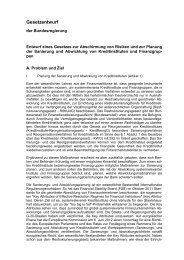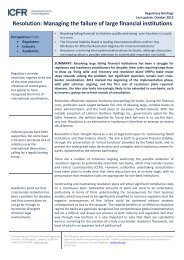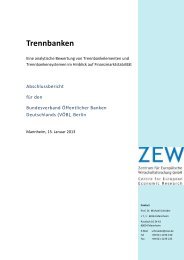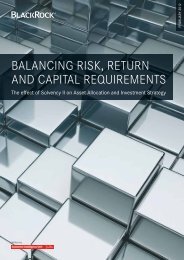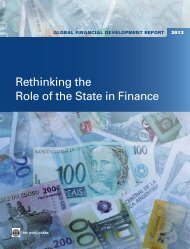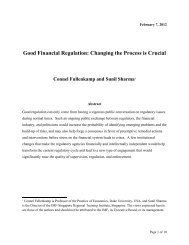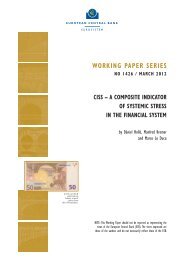A Proposal for the Resolution of Systemically Important Assets and ...
A Proposal for the Resolution of Systemically Important Assets and ...
A Proposal for the Resolution of Systemically Important Assets and ...
Create successful ePaper yourself
Turn your PDF publications into a flip-book with our unique Google optimized e-Paper software.
Consider <strong>for</strong> instance <strong>the</strong> “run” onBear Stearns. 18 As an intrinsic part <strong>of</strong> its business,<br />
Bear Stearns relied daytoday on its ability to obtain shortterm finance through secured<br />
borrowing. At this time, Bear was reported to be financing $85 billion <strong>of</strong> assets, primarily<br />
mortgagebacked securities (MBS), on <strong>the</strong> overnight market (Cohan, 2009). Beginning late<br />
Monday,March10 th ,rumorsspreadaboutliquidityproblemsatBearStearns.Counterparties<br />
became unwilling to lend on customary terms. In particular, Federated <strong>and</strong> Fidelity – two<br />
moneymarketsusuallyrollingover$5billioneach<strong>of</strong>rep<strong>of</strong>inancingtoBear–didnotrollover.<br />
Thisunwillingnesst<strong>of</strong>undonasecuredbasisplacedenormousstresson<strong>the</strong>liquidity<strong>of</strong>Bear<br />
Stearns.OnTuesday,March11,<strong>the</strong>holdingcompanyliquiditypooldeclinedfrom$18.1billion<br />
to$11.5billion(seeFigure5).OnThursday,March13,BearStearns'liquiditypoolfellsharply<br />
<strong>and</strong>continuedt<strong>of</strong>allonFriday.In<strong>the</strong>end,<strong>the</strong>fear<strong>of</strong>rep<strong>of</strong>inanciersthat<strong>the</strong>ywouldbeleft<br />
withhighlyilliquidMBScollateraltosellin<strong>the</strong>marketledtoa“run”<strong>and</strong><strong>the</strong>nearfailure<strong>of</strong><strong>the</strong><br />
firm<strong>and</strong>waseventuallysoldwithassistance<strong>of</strong><strong>the</strong>FederalReservetoJPMorgan.Incontrast<br />
to<strong>the</strong>smoothlyrisinghaircutsin<strong>the</strong>bilateralrepomarketshowninFigure4,financingterms<br />
<strong>for</strong> Bear Stearns in <strong>the</strong> triparty repo system did not rise dramatically, but it experienced a<br />
sudden freeze or a “run” from some <strong>of</strong> its largest repo financiers who feared acquiring <strong>the</strong><br />
underlyingcollateral<strong>and</strong>firesellingitinanilliquidmarket.<br />
<br />
AfterBearStearnscollapsedinMarch2008,<strong>the</strong>Fedintroduceditsmostradicalchange<br />
inmonetarypolicysince<strong>the</strong>GreatDepressionbyextendingitslender<strong>of</strong>lastresortsupportto<br />
<strong>the</strong> systemically important primary dealers through <strong>the</strong> new Primary Dealer Credit Facility<br />
(PDCF).However,eventhisextension<strong>of</strong><strong>the</strong>lender<strong>of</strong>lastresortfacilitydidnotprevent<strong>the</strong>run<br />
on Lehman Bro<strong>the</strong>rs, as investors realized that this support was not unconditional <strong>and</strong><br />
unlimited(seeAcharyaetal,2009). 19 <br />
<br />
Indeed, using data collected by <strong>the</strong> FRBNY to document quantitative features <strong>of</strong> this<br />
market, Copel<strong>and</strong>, Martin <strong>and</strong> Walker (2010) studied <strong>the</strong> triparty repo market <strong>and</strong><br />
demonstratedthathaircutsin<strong>the</strong>tripartyrepomarketbarelymovedduring<strong>the</strong>crisis.They<br />
foundthatboth<strong>the</strong>level<strong>of</strong>haircuts<strong>and</strong><strong>the</strong>amount<strong>of</strong>fundingweresurprisinglystableinthis<br />
marketduring<strong>the</strong>periodfromJuly2008toearly2010<strong>for</strong>which<strong>the</strong>yhaddata. 20 Although<strong>the</strong><br />
stability <strong>of</strong> <strong>the</strong> margins was in contrast to evidence from o<strong>the</strong>r repo markets, <strong>the</strong>y provided<br />
evidence that “this apparent stability did not prevent <strong>the</strong> triparty repo market from<br />
contributing to <strong>the</strong> problems experienced by Lehman Bro<strong>the</strong>rs, … The available evidence<br />
suggeststhatrunsin<strong>the</strong>tripartyrepomarketmayoccurprecipitously,moreliketraditional<br />
bankruns,ra<strong>the</strong>rthanmanifest<strong>the</strong>mselvesin<strong>the</strong><strong>for</strong>m<strong>of</strong>largeincreasesinmargins.”Figure6,<br />
<br />
18 The discussion that follows is based on <strong>the</strong> Securities <strong>and</strong> ExchangeCommission press release on March 20,<br />
2008 entitled, “Chairman Cox Letter to <strong>the</strong> Basel Committee in Support <strong>of</strong> New Guidance on Liquidity<br />
Management,”availableat:http://www.sec.gov/news/press/2008/200848.htm<br />
19 While<strong>the</strong>largesthaircutjumpinFigure4correspondsto<strong>the</strong>collapse<strong>of</strong>LehmanonSeptember15,2008,<strong>the</strong><br />
secondlargestjump,whichcamein<strong>the</strong>summer<strong>of</strong>2008,correspondstotraditionalbankrunsonlikelyinsolvent<br />
bankinginstitutions,suchasIndyMac,WashingtonMutual<strong>and</strong>Wachovia.<br />
20 This finding is also corroborated in Krishnamurthy, Nagel <strong>and</strong> Orlov (2011), who also attribute <strong>the</strong> relative<br />
stability<strong>of</strong><strong>the</strong>tripartyrepomarketto<strong>the</strong>substitute<strong>for</strong>rep<strong>of</strong>undingprovidedbyFedinitiatedliquidityfacilities<br />
againstilliquidcollateral,especiallyfollowing<strong>the</strong>collapse<strong>of</strong>BearStearns.<br />
<br />
21



